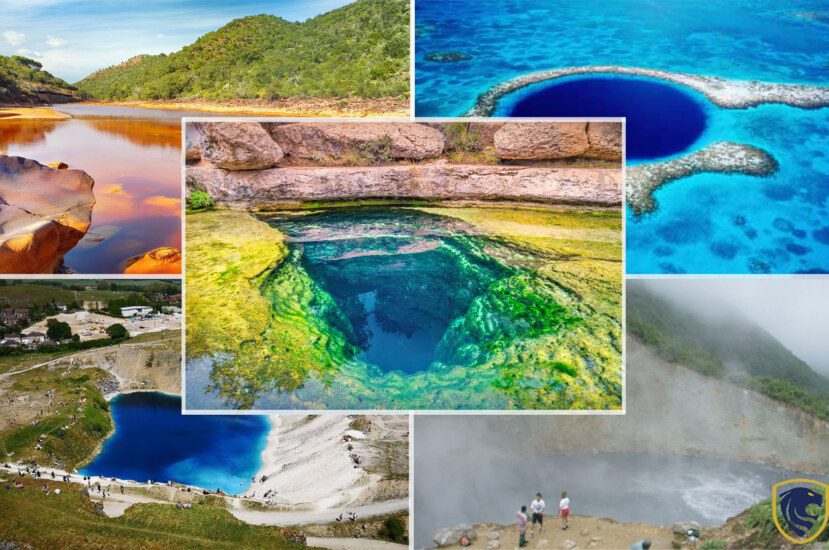Who wouldn’t like to try swimming in natural waters whenever traveling to a new country? But as we all can expect it can be dangerous. Some waters seem extremely beautiful from the outside but have dangerous circumstances that can take anyone’s life.
The Great Blue Hole, Belize
This is considered the largest and deepest undersea sinkhole in the world. It extends 984 feet wide and 410 feet deep. The dimensions explain all about its hazardousness. This hole gained enormous popularity after Jacques Cousteau included it among the top 10 diving locations in the world in 1971.
However divers must be especially cautious while exploring its depths due to its tides. Because these tides generate powerful spinning vortexes that can suck in almost anything. Also, due to the dive’s extreme depth, if something goes wrong, it might swiftly turn devastating.

The Great Blue Hole, Belize
To study the Blue Hole’s innards, two submarines dove within it in December 2018. The crew virtually finished a 3-D map of the 1,000-foot-wide hole using sonar scans. They made many observations. One of which was a layer of hydrogen sulfide at a depth of around 300 feet. Moreover, beyond that depth, the water is black, anoxic, and lifeless. Out of the three divers who were thought to have vanished while diving there, the submarine expedition found the bodies of two more at the bottom.
Drake Passage
The Drake Passage continues into the Southern Ocean and links the Scotia Sea in the southwest of the Atlantic Ocean with the South Pacific Ocean. Sir Francis Drake, an English adventurer, and privateer is honored in the passage’s name.
This water passage has become one of the most dangerous waters in the world. This is a result of strong currents brought on by the absence of surrounding land, as well as the potential for powerful waves. This occurs especially during stormy seasons. These water currents are the largest current on the planet and may move at speeds of up to 150 million cubic meters per second in some places.

Drake Passage
Many polar explorers consider crossing the Drake Passage to be a necessary step in getting to Antarctica’s natural beauties. This is a traditional aspect of Antarctic exploration. It is totally up to you whether you want to fly or cruise for this journey. And Quark Expeditions has you covered regardless of your choices. The flight option has the extra advantage of saving time and saving you from these dangerous currents. But the cruise option has traditionally been thought of as the typical arctic experience.
Jacob’s Well, Texas
Northwest of Wimberley, Texas, sits the stunning and appealing swimming hole known as Jacob’s Well. You wouldn’t realize it had taken at least 8 or 9 lives in a previous couple of years just by looking at it.

Jacob’s Well, Texas
You should be alright if all you want to do is swim and you can stay afloat. Jacob’s Well’s draw as a diving destination is where the actual risk resides. The main hole is over 4,341 feet deep. So, getting to the bottom would take a significant amount of oxygen.
The irrigation hole is full of clogged chambers and tunnels. So, it’s not nearly as easy. Divers have lost their lives in the process of exploring it and even just trying to bring their corpses back to the surface.
Rio Tinto River, Spain
Swimming in a river that is stained crimson like blood is probably the last thing you would want to do. You’d probably be correct in the instance of the Rio Tinto River in Spain. Although it is stunning in its special way, this area is extensively contaminated by iron and other heavy substances. That makes it one of the last locations you would want to drink water from. If that weren’t awful enough, the water is rather corrosive. So, anyone wishing to swim or enjoy the water should certainly look somewhere else.

Rio Tinto River, Spain
The river is so contaminated because of human activities, as you would have imagined. The river’s condition has been affected by mining which had been continued for more than 5,000 years.
Bizarre types of life do, nonetheless, flourish in the most hostile environments. Rio Tinto’s river is home to chemolithotrophic species. Such as sulfur- and iron-oxidizing bacteria. Chemolithotrophs obtain energy by oxidizing inorganic chemicals, which are also in charge of the river’s hue and overall mood.
The Boiling Lake
Who would anticipate something nearly as frightening as a boiling lake on the laid-back Caribbean island of Dominica? This lake is located in New Zealand. From Roseau, the nation’s capital, hikers must travel 6.5 miles to reach the lake through the Valley of Desolation. There they will encounter a boiling stream and smaller boiling ponds. Although you might want to take a swim in the lake after the climb, it is not advisable. Because the water is hot enough to cook an egg.

The Boiling Lake
Horseshoe Lake, California
Due to its location on Mammoth Mountain’s outskirts, Horseshoe Lake is a very popular hiking and outdoor leisure site.
Due to the severe snowfall in the region, entry is only permitted for skiers and snowshoers during the winter. Several of the springs that feed the lake dry up during the drier summer months, creating sandy beach areas for tourists to enjoy.

Horseshoe Lake, California
Then in 1989, a series of earthquakes opened up the soil, allowing dangerously high levels of CO2 to escape from the lake’s bottom. It destroyed more than 100 acres of forest. Horseshoe Lake is been continuously under observation. Because Mammoth Mountain is a young volcano that continues to allow potentially fatal volumes of carbon dioxide to seep through it.
The Blue Lagoon, Derbyshire
These once rank among the most beautiful “lakes” on the list, at least historically. The lake had a beautiful, vivid blue hue that drew swimmers in. Despite multiple warnings and signs that were placed, people continued to swim in the lake that was built after a severe flood for many years. In 2013 and 2020, the water was intentionally tinted black to deter swimming there.

The Blue Lagoon, Derbyshire
This “lake” was poisoned despite its beauty. Caustic compounds were the reason for its blue hue. The lake’s pH level was 11.3, which is lower than the pH of home bleach, which is 13. Even getting near the water in this lake sounds like a bad idea. The toxins may irritate and result in gastrointestinal issues which can lead to a series of other health issues. Also, there are signs warning people that dead animals, automobiles, and other debris have contaminated the water.




